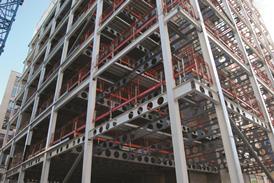The government has come up with a startling solution to the barriers to home ownership: to use public land and industrial production to build 60,000 £60,000 houses. Housebuilders are currently competing to design the prototype. We find out how it’s supposed to work.
When deputy prime minister John Prescott stood up at the Labour party conference in September to say he was going to provide first-time buyers with £60,000 houses, onlookers’ brows furrowed. Was this mindless conference bluster? Had Prescott signalled a return to socialist interventionism in the sacred free market? Or had he, as is often the case, misread the autocue?
As it turned out, Prescott knew exactly what he was saying. He has a big idea to marry the government’s policies on sustainable communities, selling public sector land and using modern methods of construction. But could the construction industry deliver what he wants? Statistics prepared by the RICS say the average building cost for a two-bedroom house last year was £71,000, not including land, infrastructure and other development costs. So how is Prescott’s great plan going to work?
The government wants to get more people on the property ladder. To do this, it needs some way of lowering the bottom rung. Figures from the RICS indicate that the market price of an affordable house is about £180,000, rising to £218,000 in London. This means that even if the government succeeds in getting the E E industry to build the 200,000 extra homes needed over the next 10 years, too few people will be able to buy them. On the other hand, developers won’t build unless they can make a profit.
Prescott’s idea is to split the costs of buying land from the cost of building a house. When you purchase a house, you usually buy the freehold of the land, and that probably accounts for the largest element of the price. The first big idea is to remove the land from the equation by building on land the government already owns.
The second big idea is to make the house cheaper. The RICS’ £71,000 price tag is regarded by the ODPM as £11,000 too much. It wants houses to be assembled in factories out of steel panels and moved to site in large modules. This process used to be known as prefabrication, but now labours under the unlovely term “modern methods of construction”. The change is for marketing purposes: the public associated prefab with cheap and ugly buildings, and the construction industry it with expensive and ugly ones. MMC, on the other hand, encompasses recent advances in sustainability and design quality. And because the government is providing commitment and land, manufacturers can invest in production lines secure in the knowledge that they will have long production runs – the ODMP is talking about 60,000 homes. The end result is higher volume and lower unit cost: QED.
The other way building can be made cheaper is a personal favourite of the deputy prime minister’s. Prescott is obsessed with the idea that housebuilders’ profits are too high. In his conference speech he blasted the sector for the 60% rise in social housing building costs since 1997, much greater than in Europe. “It’s been a gravy train for some,” he complained. “And it’s got to stop.”
Accordingly, the industry is gearing up to work out how it could build a £60,000 house. Last Monday, English Partnerships launched a competition to find the developer that could come up with the best value house; firms such as Westbury, Countryside, Bellway and Redrow are understood to be interested in the idea. None wished to share their ideas with ��ɫ����TV, however: Redrow said it “would not discuss new innovations” with the media, although it is thought to have worked up house using a system called Debut. It will be intriguing to see how well they can perform.
The key
And yet the frenzy over cost is, perhaps, beside the point. Regardless of whether the developers can come up with a £71,000, a £60,000 or a £10,000 home, the real issue is the provision of public land. Tony Burton, a partner in cost consultant Gardiner & Theobald, says: “If you have the sites, and you can overlay MMC to reduce costs even further, then the process will be cheaper.” In other words, even if the buyer’s initial equity stake is as much as £100,000, this is still much better than paying the market rate.
Trevor Beattie, EP’s director of corporate strategy, will spend most of the urban summit next week ensconced in a model of a house designed by architect PRP (pictured). This is “categorically not” the £60,000 home; it is intended to show the potential of MMC. But Beattie says he is excited by what the scheme could achieve, and is sufficiently bullish to say that there will be a line of £60,000,
Prescott is obsessed with the idea that housbuiilders’ profits are too high
two-bedroom houses at the Allerton Bywater Millennium Community in Yorkshire. “We’ve already proved to ourselves that we can do it,” he says. “So have Redrow with their Debut system. The project gives us the chance to draw together all the work on MMC, ecohomes and quality design. Getting the volumes of these houses going is the point: it has the potential to get cheaper.”
Ben Denton of construction consultancy Abros shares Beattie’s enthusiasm. Abros has been working on how the £60,000 house could be used in Thames Gateway and says the critical element is the size of developments. “With standardised procurement and units it can work,” he says. “It becomes more difficult on sites of fewer than 100 houses”. Denton thinks in lower density areas, costs could be as little as £50,000. Inner city developments with higher densities, such as blocks of flats above Tube stations, require more infrastructure such as lifts to make them feasible, and thus will cost more: but could still be within the £60,000 mark.
Potential pitfalls
The deal will work like this. The buyer will take a £60,000 equity stake; this will constitute one-third or so of the cost of the house. The land will be held in trust by EP. When the buyer moves up the property ladder, they get their stake back, as well as one-third of whatever equity the house acquired after it was bought. The home is then ready for a new owner. But there are a few grey areas:
n The biggest conundrum is how the land will be administered, controlled and regulated. The thinking seems to be that EP and the Housing Corporation would form a consortium with a registered social landlord or developer, and all three would eventually gain an equity return from any rise in the value of the land. But it’s not clear whether the system would be organised on a local basis or if there would be a central government landbank. Neale Coleman, Ken Livingstone’s housing spokesman, told ��ɫ����TV that the Greater London Authority wanted to set up an equity fund that could be open to institutional investors, and which could pay for infrastructure and other associated costs.
n Infrastructure costs on private developments are usually shouldered by the developer through section 106 agreements. Developers foot the bill because they are still making a profit on the land. But if they don’t own the land, this money has to come from somewhere else. Moreover, the costs cannot be quantified because they change from site to site. This is before you consider that Prescott and EP want to build on brownfield public sector land that may need remediation. Unless the government comes up with some kind of subsidy, the costs will have to be borne by the first buyer’s equity stake. This could be why in London Ken Livingstone has suggested that the pioneers put in £120,000.
n Another conundrum is how interested developers will be in the scheme. The private sector will only get involved if there is an profit to be made. But, as Joe Martin, executive director of the RICS’ cost information service explains, in order to sell a house at £60,000 someone has to provide the clients’ costs, the design costs, and the cost of the sales team. This can amount to 50% of the construction costs. And somewhere in among this is the developer’s profit. The developer usually finances the scheme by controlling the land, but this is held by EP. So, unless the government provides some kind of subsidy then it is hard to see where the developer makes his profit – except by raising the cost to the buyer.
As promised, the big brother of the £60,000 house will be on display at the summit. It could herald the start of a shift in policy towards first-time buyers. Or the whole project could drown under the volume of things that need to come together to make it happen. It may be premature to adopt The Daily Telegraph’s line – “To call this scheme half-baked would be an insult to grocers” – but at the moment, the industry is in need of a proper recipe.
The view from- The strategist
At the last summit we were still in the excitement of ideas, but now we’re tied to delivery. The government has stuck its neck out in the north on changing the balance of supply and demand and in the south by not building in old-style single units. Before, everything was in the ether, now things are being done on the ground
Genie Turton, career civil servant who, as director-general of the ODPM, developed the sustainable communities plan. She Retired last year and is now a non-executive director at Wates
The view from- the planner
It was great news that we finally got a sustainable communities strategy.
The not-so-good news is concerned with the rate and nature of delivery. We have not got the necessary infrastructure. The southern regional assemblies have already refused to meet the housing aims because of the lack of infrastructure; Barking Reach cannot be done without an extension to the Docklands Light Railway. If infrastructure is developed, we could see a lot of new housing in the next five years
Sir Peter Hall, member of Lord Rogers’ Urban TaskForce; former regeneration adviser to Michael Heseltine.
The sustainable communities summit 2005
- 1
- 2
- 3
- 4
- 5Currently reading
The race to build the £60k houses
























No comments yet